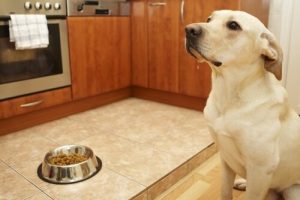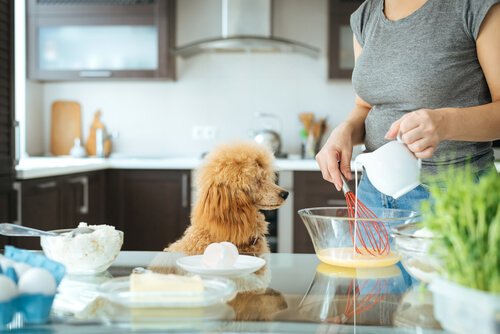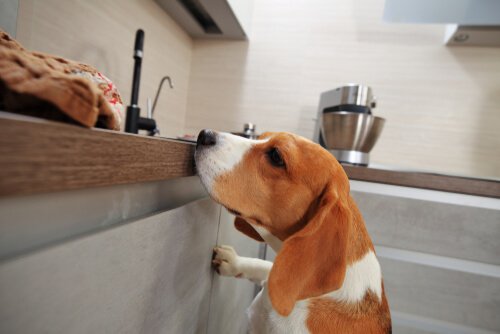Why Shouldn't there Be Animals in your Kitchen?


Written and verified by the lawyer Francisco María García
It’s normal to put the dog’s dishes in the kitchen. However, you should consider putting them somewhere else. Not only because they can become a source of contamination, but also because the animal’s food can be affected.
Food poisoning is more likely to happen in this part of the house, both for pets and people. You should give your pet his own dishes and have different cleaning supplies for his things.
Just like their owners, animals can be victims of foodborne illnesses. And this tendency increases when unprocessed food is given directly to the animal. Poor handling or storage problems are also major causes of animal food poisoning.
Reasons why there shouldn’t be animals in your kitchen
Animals can be physical and microbiological polluting agents through viruses or bacteria. They can contaminate the areas where we typically put food via their hair or natural secretions. The consequences can range from a simply allergy to an upset stomach.
However, the real problems occur via pets’ waste. Feces carry parasites and bacteria. Therefore it’s important to prevent the animal from spreading stools around the house. Even after coming back from a walk, it is crucial to wash his paws or make sure he doesn’t go into the kitchen.
Diseases associated with food contamination due to animal handling can be bacterial or viral. In the first case, the symptoms are stomach pain, diarrhea, and vomiting. If this happens they may need medical attention and treatment.

If it’s a viral infection, the discomfort goes away in three or four days. However, it’s important to go to the doctor in both cases.
It’s not just about the animal
When cooking, avoid contact with the animal and wash your hands afterwards. Petting the dog and then continuing cooking in the kitchen can cause infections. Another bad habit that you must avoid is feeding the animal the ingredients that you are using, whether raw or cooked.
It is also essential that animals’ vaccines and deworming treatments are up-to-date. This step can help decrease risk of infection, especially from bacteria.
Finally, another factor to keep in mind is the animals’ food. The safest way to feed pets is using processed food.
Prepared food needs to be stored well in order to prevent decomposition. It is important to not leave food remains in the animal’s dish.

Recommendations for animals and the kitchen
- Their own space. It’s best that the pet has his own space to eat, separate from the kitchen. If there isn’t enough available room, it is important to pick up the dish once the animal has finished eating.
- Use different cleaning supplies. It is not recommended to use the same sponge or scrubber to wash both your plates and the dog’s dishes. It’s also not advisable to feed pets from the same plates as yours. The animal should have his own dishes.
- The kitchen is not a bathroom. If the pet needs to do his business inside the house, he should have a space that is not in the kitchen. Animal excrement is highly contaminating and transmits diseases.
- Keep him from jumping on the kitchen table. This is very common in cats, who like to amble around the kitchen. This gesture, which is a sign of friendliness, can turn into an infection from the animal’s hair. It is preferable to teach him not to climb on top of kitchen furniture.
- Don’t feed the animal leftovers. This can prevent the pet from suffering any type of poisoning. One of the most common bacterial infections is salmonella.
It’s normal to put the dog’s dishes in the kitchen. However, you should consider putting them somewhere else. Not only because they can become a source of contamination, but also because the animal’s food can be affected.
Food poisoning is more likely to happen in this part of the house, both for pets and people. You should give your pet his own dishes and have different cleaning supplies for his things.
Just like their owners, animals can be victims of foodborne illnesses. And this tendency increases when unprocessed food is given directly to the animal. Poor handling or storage problems are also major causes of animal food poisoning.
Reasons why there shouldn’t be animals in your kitchen
Animals can be physical and microbiological polluting agents through viruses or bacteria. They can contaminate the areas where we typically put food via their hair or natural secretions. The consequences can range from a simply allergy to an upset stomach.
However, the real problems occur via pets’ waste. Feces carry parasites and bacteria. Therefore it’s important to prevent the animal from spreading stools around the house. Even after coming back from a walk, it is crucial to wash his paws or make sure he doesn’t go into the kitchen.
Diseases associated with food contamination due to animal handling can be bacterial or viral. In the first case, the symptoms are stomach pain, diarrhea, and vomiting. If this happens they may need medical attention and treatment.

If it’s a viral infection, the discomfort goes away in three or four days. However, it’s important to go to the doctor in both cases.
It’s not just about the animal
When cooking, avoid contact with the animal and wash your hands afterwards. Petting the dog and then continuing cooking in the kitchen can cause infections. Another bad habit that you must avoid is feeding the animal the ingredients that you are using, whether raw or cooked.
It is also essential that animals’ vaccines and deworming treatments are up-to-date. This step can help decrease risk of infection, especially from bacteria.
Finally, another factor to keep in mind is the animals’ food. The safest way to feed pets is using processed food.
Prepared food needs to be stored well in order to prevent decomposition. It is important to not leave food remains in the animal’s dish.

Recommendations for animals and the kitchen
- Their own space. It’s best that the pet has his own space to eat, separate from the kitchen. If there isn’t enough available room, it is important to pick up the dish once the animal has finished eating.
- Use different cleaning supplies. It is not recommended to use the same sponge or scrubber to wash both your plates and the dog’s dishes. It’s also not advisable to feed pets from the same plates as yours. The animal should have his own dishes.
- The kitchen is not a bathroom. If the pet needs to do his business inside the house, he should have a space that is not in the kitchen. Animal excrement is highly contaminating and transmits diseases.
- Keep him from jumping on the kitchen table. This is very common in cats, who like to amble around the kitchen. This gesture, which is a sign of friendliness, can turn into an infection from the animal’s hair. It is preferable to teach him not to climb on top of kitchen furniture.
- Don’t feed the animal leftovers. This can prevent the pet from suffering any type of poisoning. One of the most common bacterial infections is salmonella.
This text is provided for informational purposes only and does not replace consultation with a professional. If in doubt, consult your specialist.








